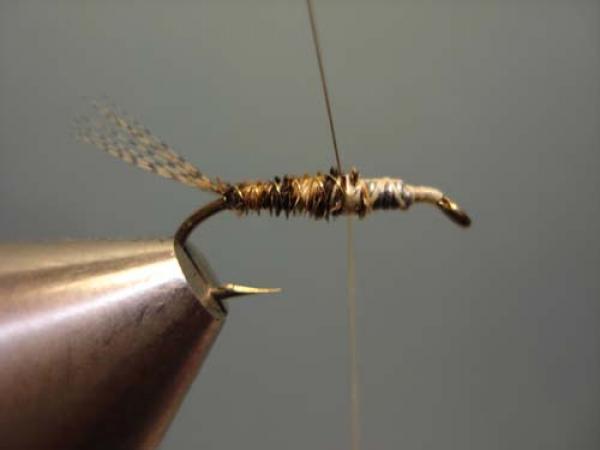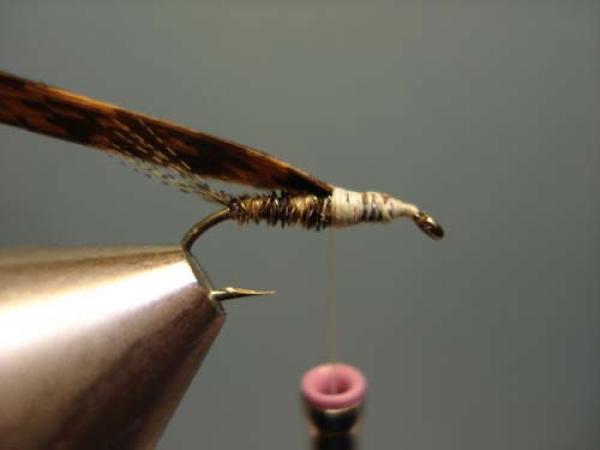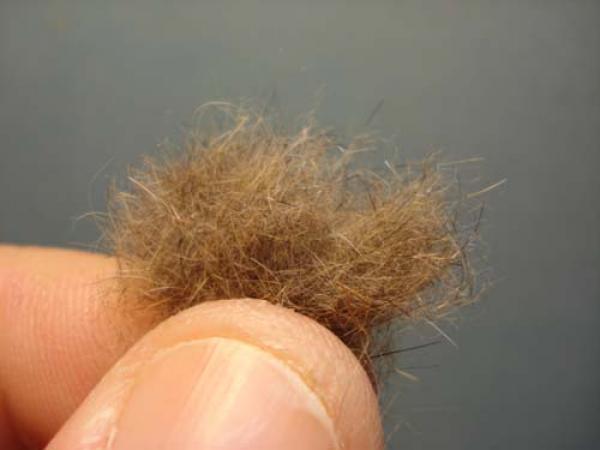Archives of Loren Williams Fly Tying Tutorials.
LW's Light Quill Sulphur
Fly and Photos by Loren Williams
The "Sulphurs" are typically represented with the three Ephemerella species invaria, rotunda, and dorothea. E. invaria is the largest at #12-#14 and hatches first, followed by E. rotunda (#14-#16), and E. dorothea (#16-#18). While the duns and spinners of these species are all relatively similar in appearance, the nymphs are not. While attending Penn State, the owner of the local fly shop, Steve Sywensky, made me aware that the two larger, earlier species have a decidedly darker nymph than the smaller, latter species.
The nymphs do have some commonalities in that they have heavily speckled, prominent legs, and short speckled tails. Overall the nymphs will appear quite mottled, and as they reach maturity their thoraxes will broaden and their wing cases will darken. Most streams that have sulphurs have strong populations of at least some of the species. During hatch time the nymphs are often the top menu item. It is at this time, if ever, that more specific imitations-beyond Pheasant Tails and Hare's Ears will be required.
There are multitudes of dubbed sulphur nymphs which can be deadly if tied judiciously. However, too many folks over-dub their patterns creating inaccurate profiles and flies that do not sink properly. I also see too many dubbing blends that are monotone. Nothing in nature is a single color! I have found that quill bodied nymphs are easier for most folks to tie in a slim fashion, sink well, and very accurately imitate the mottled appearance of most mayfly nymphs.
What follows is the light sulphur (E. dorothea) nymph I'll turn to if my more generic patterns fail. I've also completed a tutorial of the invaria/rotunda nymph I'd use, the LW's Dark Quill Sulphur nymph.
Hook: Mustad 3906B or 3399 (#14-#16)
Weight: .015 or .010 lead wire (optional)
Thread: TanTails: Wood Duck Flank
Rib: Fine gold Wire
Abdomen: Golden Pheasant Tail Quill
Wing Case: Natural turkey tail quill (or blacked dyed quill at hatch time)
Thorax: Natural Hare's Mask
Legs: Wood Duck Flank

Place hook firmly in your vise.

Attach 10 wraps of .015" lead wire and slide it to the thorax area.

Attach your thread behind the eye and coat the shank. Take time to build a taper on each end of the lead coil.

Select and remove a few fibers from a drake wood duck flank feather. Imitation wood duck can be used btu will not yield as nice of a result as the well-marked stiff "woodie" fibers.

Measure, with tips to the rear, to be equal to 1/2 the hook length.

Secure with tight thread wraps as the rear...

...and bind forward to the lead coil. Notice that we are using the excess material to further build the abdominal taper.

End with your thread at the middle.

Select some fine gold wire.
Secure it at the middle and bind it to the rear on the far side of the hook shank as shown.


Even the tips on a section of quill fibers from a Golden Pheasant Tail (hen ring-necked pheasant is a viable substitute).

Snip them away.

Tie in by the tips at the rear.

Wrap the bundle forward and secure it at the middle of the hook. You should be slight up on the lead wire coil. Snip the excess.

Counter rib the gold wire by wrapping in the opposing direction. I often make my first wrap snug under the tail, this will cause the tail to stand slightly up from the hook.

Secure in the middle and snip the excess.

Snip away a slip of quill fibers from a turkey tail (or black dyed goose/turkey quill).

The slip should be about twice as wide as the hook's gap.

Fold the slip in half with the undersides touching.

Square-off the tip.

With the squared tip forward, secure the turkey slip on top of the thorax region. Be sure you are maintaining a 1/2 abdomen, 1/2 thorax proportion.

Apply some tacky wax to your thread.

Select a pinch of Hare's mask dubbing.

Touch the dubbing to the waxed portion of the thread just enough to let the wax grab some fibers.

You should have this.

Spin your bobbin holder, either direction will work well.

Now you have this.

Dub the thorax, be sure to wrap back onto the wing case a few turns as it will pull forward later.

Snip the top away from the wood duck feather you used for the tail.

Secure it at the head with 2 rather loose wraps of thread, with the tips to the rear.

Pull the feather through the thread wraps until the tips extend just past the rear edge of the wing case.

Lock the feather in place.

Snip the excess.

Press down with your thumbnail to cause the fibers to split.

Pull the wing case forward through the split wood duck fibers.

Press down with your thumb and secure with 2 tight wraps of thread.

Lift the slip back and take two wedge wraps.

Cut your slip close without fear of cutting your thread!

ull any stray fur or fibers to the rear, form a neat head and whip finish.

A completed LW's Light Quill Sulphur Nymph.

The same pattern but with a black wing case for use at hatch time.

A simple and effective bead head version for the fast water.